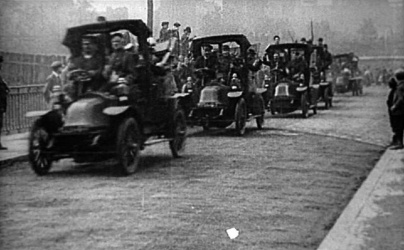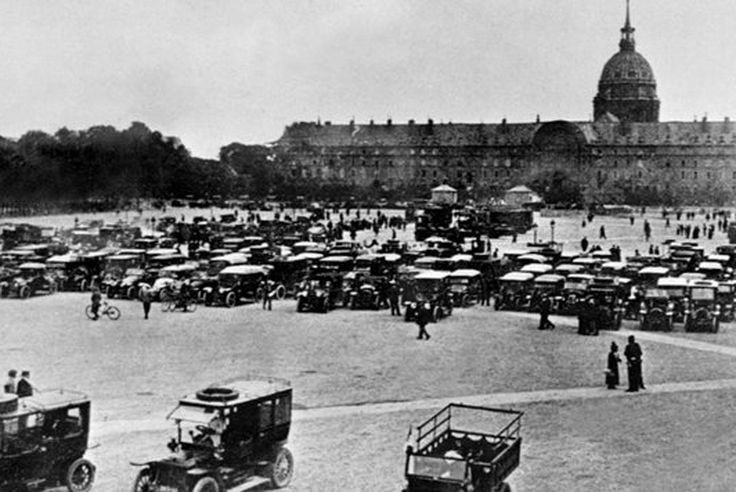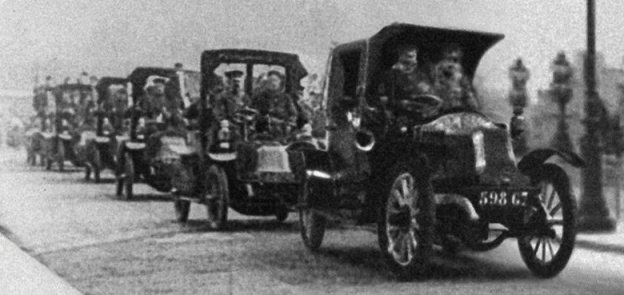On September 6 and 7, 1914 as the German army has crossed the Marne, the French general staff requisitions 1,300 Paris taxis as there are not enough trains to quickly send infantrymen to support the front and stop the enemies’ break, these are the “Taxis de la Marne” or “Marne Taxis”.
The French army has been struggling since the beginning of September on the front, while the enemy is getting dangerously close to the capital city and takes the advantage for the first week of the First world War. Threatened by likely bombings, the government leaves Paris to go to Bordeaux.
The first battle of the Marne begins on September 5, north-east of Paris, and is likely – in the event Allies failed – to go to the hands of the Germans. On the left bank of the river, the French and British armies face off the enemies positioned across the river. The front – covering 300km – sees 900,000 German soldiers face off one million French and British soldiers, while five battles are led at the same time on the battlefield.
But the situation is critical. On the evening of September 5, French Army Operations Commander-in-chief General Joseph Joffre writes the order of the day that will be spread on the 6th at 7:30 a.m.: “At the moment when the battle upon which hangs the fate of France is about to begin, all must remember that the time for looking back is past; every effort must be concentrated on attacking and throwing the enemy back…Under present conditions no weakness can be tolerated”.
Faced with the general’s resoluteness, and while German uhlans have been reported only a few dozen kilometers off Paris, Paris military governor General Joseph Gallieni, General Jean-Baptiste Clergerie and André Walewski – founder of the Compagnie Française des Automobiles de Place – have a brilliant idea to support General Maunoury’s 7th army at the far left of the allies’ plan, across the 1st army of German commander Alexandre Von Kluck.
In order to quickly send French troops as backup by the battlefield and to achieve a striking operation aiming at keeping away and destroy the German vanguards, the French general staff decides to requisition Paris taxis, as the train networks around Paris are not enough, more or less overwhelmed and often unorganized.
As a matter of fact, the idea is not new. In late August 1914, taxis already took part in supplying Paris’ entrenched camp under the initiative of Commissary General Burguet. Since then, General Gallieni owns a permanent stock of 150 taxis available by day and by night, likely to be tripled up within a few hours – the capital city actually owning 10,000 taxis, but 7,000 drivers are already used for war.
In the night from Sunday September 6 to Monday 7, 1941, 630 Paris taxis – mostly Renault AG-1 Landaulet, gather in the cour des Invalides. Driving at 25km/h (15.53mph) each taxi can take up to five men with their kits. The first convoy heads to Tremblay-Lès-Gonesse and Mesnil-Amelot before reaching Livry-Gargan and Sevran-Livry, while the second convoy with 700 cars leaves later in the day to go to Gagny.
Once they made it to the supply point, taxis take on board 6,000 infantrymen from the 14th brigade of the 7th division of infantry units commended by General Edgard de Trentinian. In the night of Monday September 7, the two battalions of the 104th infantry unit arrive at Nanteuil-le-Haudoin in Oise, closely followed by the three battalions of the 103rd infantry unit arriving on September 8 at dawn at Silly-le-Long, south of Nanteuil-le-Haudoin.
Once soldiers are dropped by the Marne front, taxi drivers head back to Paris and companies are paid 70,102 francs by the Ministry of War, namely the price displayed on the clock for usual fares.
Although the episode of the Marne taxis was not decisive in the first Battle of the Marne, the initiative yet contributed to stop the enemies and marks the history and minds in a way more psychological than military. Because of its never-before-seen extent and the population’s commitment, the Marne taxis go down in history and quickly become a symbol of solidarity, unity and national determination.
Several Marne taxis have been purchased to perpetuate the memory of this iconic event: two Renault G7 cars are displayed at the Musée de l'Armée set within the Hôtel des Invalides and at the Meaux Musée de la Grande Guerre.
Location
Hôtel national des Invalides
129 Rue de Grenelle
75007 Paris 7



























